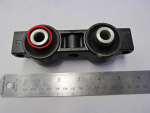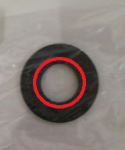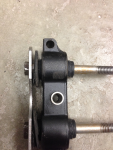No Title
F_R that would also be my best guess. It is just still weird that the wholes in the washers are not made to fit the bolts to sit tight between the bolt head and the metal tube part whitch is part of the rubber mount assembly.
I have noticed that the rubber mount assembly has a sligthly smaller diameter on the most outer part, which just allows for the rubber washer to fit here. I guess that makes it somewhat sit semi-tight in that position when all tightened together.
In the attached picture here the following applies:
- the rubber mount assembly is made up from a metal outer piece (the black piece you can see), then some rubber inside the outer piece, then two metal tubes inside the rubber to accomodate the two long bolts. The rubber "glues" the outher piece and the metal tubes together and stretches out along the metal tube on both sides of the out piece.
- the rubber within the rubber mount assembly obviously dampens vibrations between engine and boat
- rubber mount assembly is attached to the upper part of the engine through the wholes that you can look through on the picture
- the long bolts go through the steering arm assembly which is connected to the part that sits on the boat. So the boat would be on the right in this picture.
- the shiny piece is just a retaining plate. This makes the bolts move together and also makes sure that the upper part of the engine cannot slide off the bolts in case the rubber mount assembly comes apart (since the gluing/molding of the rubber mount assembly is vital)
If you look closely you see that I have not put the bolts all the way through. Just to the right of the shiny retaining plate along the top bolt in the picture you see the diameter of the bolt itself (it has an uneven surface at this end to make a press fitting inside the rubber mount assembly, I guess - just in case you wondered) . If you continue right you see the rubber washer and just to the right of the rubber washer you have the flange of the rubber mount assembly - this has a larger diameter than the bolt. The rubber washer sits on the outside of this larger diameter rubber flange (with the metal tube inside it). However, as mentioned, the rubber flange has a slightly smaller diameter inside the rubber washer (not visible due to the washer) than it has where you can see it to the right of the rubber washer. This allows for the rubber washer to stay there when tightened.
My best guess for purpose of the rubber washer would be, that this rubber washer protects the retaining plate and the rubber mount assembly from touching each other in cases where the engine really strains/bends the rubber mount assembly. It is still a guess and if I am right, it still poses a question towards why the engineers haven't just used a rubber washer with a diameter that would fit the bolt instead of making this special outer diameter on the rubber mount assembly to keep the rubber washer in place.
If a rubber washer with a smaller hole (to fit the bolt exactly) was used to fit them in between the retaining plate and the flange, the washer would be held in place in between like any other washer and rubber mount assembly would be more simple.
Now staying along my own guess toward the purpose of the rubber washer.... I need to find an explanation on why the rubber washer is engineered to be mounted in this peculiar way. If indeed the washer had been mounted with a smaller hole as I suggested, maybe the rubber washer would come apart quicker as it would get squeezed by moving metal on both sides (retaining plate on one side and metal tube on the other side). In the solution the engineers came up with it is only squeezed by metal on one side (the retaining plate).
Please let me know if you think my guessing seems plausible or if you have some other thoughts on the matter.























